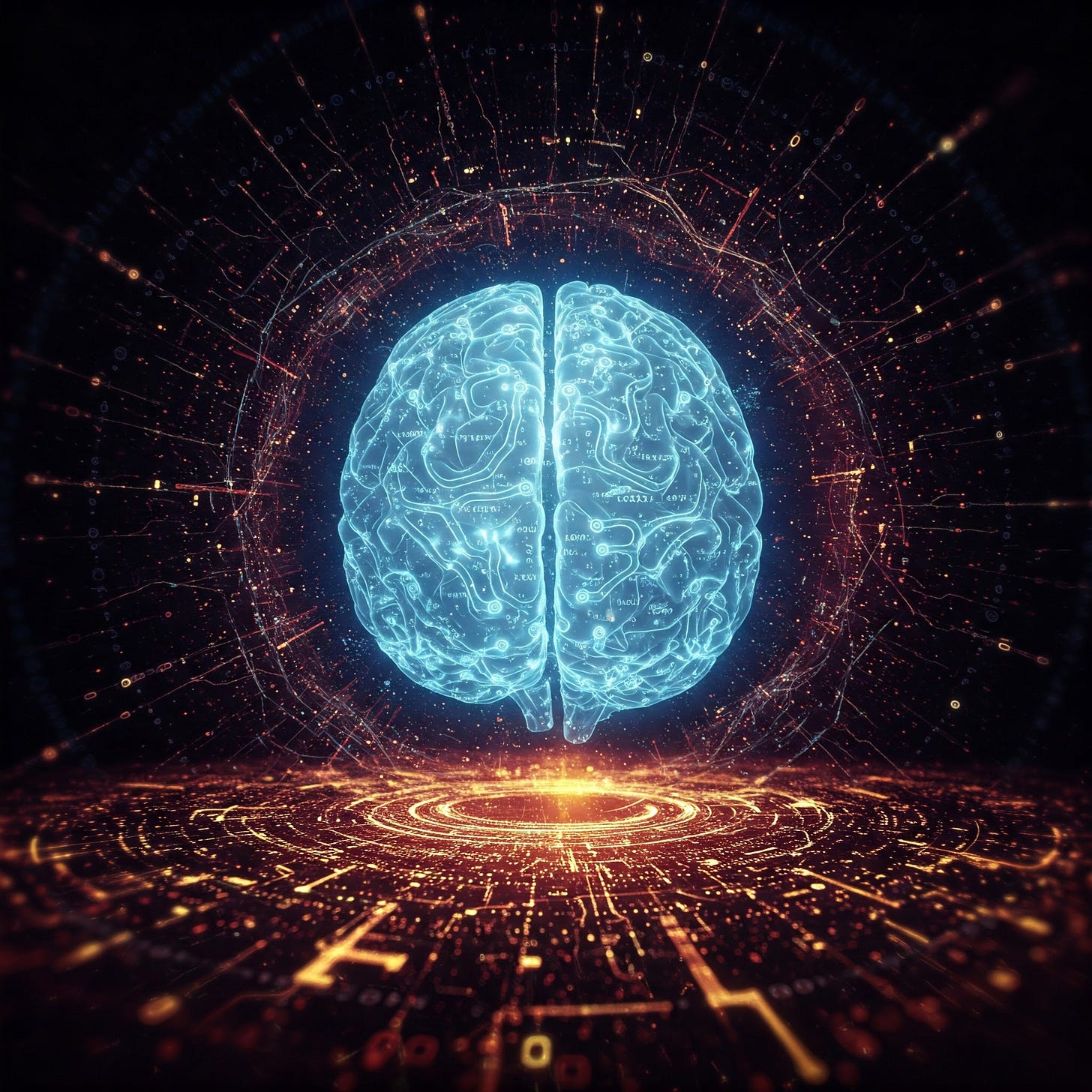AI Emergence: Emergent Behaviors in Artificial Intelligence - This is Expected, Not Really Surprising
More emergence should be expected from AIs... doesn't mean it's "novel"
Over the past few years, the rapid scaling of artificial intelligence (AI) systems—especially large language models (LLMs)—has led to the observation of behaviors that were never explicitly programmed.
These so-called “emergent behaviors” appear when models are trained on vast and diverse datasets, enabling them to perform complex tasks in ways that seem novel or unexpected.
While this excites some, scares others, etc. — the “emergent behavior” is just a byproduct of synthesizing training data, and generating something that it wasn’t explicitly trained on. Humans exhibit “emergent” learning too.
Human “emergent” learning:
Exposure to Words: A child hears many words in everyday conversations.
Imitation of Phrases: The child begins repeating short phrases and sentences without formal instruction.
Recognition of Patterns: Over time, the child notices consistent word orders (e.g., "Subject + Verb + Object").
Internalization of Grammar Rules: Even without being taught the rules explicitly, the child subconsciously learns how sentences are structured.
Novel Sentence Construction: The child starts creating new sentences, like "The cat chases the ball," even if they haven't heard that exact sentence before.
This is technically “emergent” behavior from basic exposure and imitation… one’s brain learns to combine patterns and generate new grammatically accurate sentences.
AI Language Models:
A large-language/AI model learns grammar, vocabulary, and syntax from vast amounts of text/data:
Step 1: Learning Components: The model is exposed to words, sentence structures, and common language patterns.
Step 2: Pattern Recombination: It learns to predict subsequent words based on prior context.
Emergent Behavior: Over time, the model begins to generate coherent, creative content—like composing poetry or solving novel problems—even if it hasn’t seen those exact examples during training. This isn’t mysterious; it’s the result of recombining learned linguistic elements in new ways.
RELATED: Will AI Inference / Test-Time Compute Scaling Yield “Novel” Breakthroughs?
Defining “Emergence” Behavior or “Emergent” AI Properties
Emergent behavior refers to capabilities that arise from the interactions of many simple components within a system rather than from direct programming. In AI, it is observed when a model begins to perform tasks or demonstrate abilities that were not explicitly part of its training objectives.
Unexpected Onset: As models scale up—whether in terms of parameters, training data, or computational resources—they may suddenly acquire new capabilities. This phenomenon is often likened to phase transitions in physics, where gradual changes lead to abrupt, qualitative leaps in behavior.
Complex Recombination: Even though emergent abilities seem surprising, they typically result from the model having been exposed to all the necessary supporting information during training. For example, a model trained on vast Linux documentation and forum posts might later emulate a Linux terminal, not because it was directly taught to do so, but because it has internalized the patterns and interactions underlying terminal usage.
Subjectivity in Interpretation: There is debate about whether emergent behavior is truly novel or simply an expected outcome of large-scale training. Some argue that what we label as emergence is merely the natural recombination of learned data, while others contend that these behaviors represent a genuine leap in AI capabilities.
Historical Context & Early Observations
Early AI Models: Historically, AI systems were built on simple rules or statistical models that did not exhibit emergent properties. Their capabilities were predictable and directly tied to their programming.
Advent of Deep Learning: With the rise of deep learning, models began to scale from millions to billions of parameters. This increased complexity allowed models to internalize vast amounts of information, leading to unexpected performance leaps in tasks like language translation, reasoning, and arithmetic.
Pioneering Examples:
GPT-3 (2020): With its 175 billion parameters, GPT-3 was among the first models to demonstrate capabilities—such as multi-digit arithmetic, contextual reasoning, and in-context learning—that surpassed the performance of smaller models.
PaLM (Pathways Language Model): Showed advanced emergent behaviors, such as chain-of-thought reasoning, where the model could break complex problems into intermediate steps without explicit instruction.
Subsequent Models: Systems like GPT-4, Anthropic’s Claude 3, and OpenAI’s o3 have continued to refine these emergent behaviors, exhibiting even more sophisticated capabilities.
Specific Examples of Emergent Behavior in AIs
1. Mathematical and Logical Reasoning
Multi-Digit Arithmetic: Smaller models might fail at even basic multi-digit operations. However, larger models suddenly demonstrate the ability to perform accurate multi-digit addition and multiplication—a leap that appears once a certain scale is reached.
Chain-of-Thought Prompting: Models like PaLM and later GPT iterations can break down complex problems into logical, intermediate steps. This emergent ability is not directly taught but arises from the internal recombination of learned patterns.
2. Language Understanding and Translation
Decoding Complex Notations: Large models have shown the capability to decode and understand specialized notations, such as the International Phonetic Alphabet (IPA), simply by learning from the patterns present in their training data.
Cultural and Linguistic Nuances: Models such as GPT-3 can translate culturally specific content (e.g., Kiswahili proverbs) into English without having been explicitly trained on that task—demonstrating a capacity for abstract understanding.
3. Few-Shot and Zero-Shot Learning
Few-Shot Learning: Given only a handful of examples at inference time, models like GPT-3 can generalize to new tasks. This ability emerges from exposure to extensive and diverse training examples.
Zero-Shot Learning: Some models can perform tasks with no direct examples at all—such as detecting offensive content in mixed-language text—further demonstrating that emergent behavior often comes from the breadth of data rather than explicit instruction.
4. Complex Prompted Tasks and Simulation
Linux Terminal Emulation: A notable example is when GPT-3 convincingly emulated a Linux terminal. Despite no specific training for terminal interaction, the model’s extensive exposure to Linux-related text allowed it to reconstruct terminal-like behavior.
Educational and Examination Performance: Models like LaMDA and Gopher have been reported to perform well on college-level exams, with their performance improving dramatically at larger scales.
5. Creative Outputs
Art and Music Generation: AI systems trained on diverse creative datasets have begun to produce art and music that not only replicate human styles but sometimes introduce new combinations, challenging conventional definitions of creativity.
The Debate: Expected vs. Unexpected Emergence in AI Models
While emergent behaviors in AI may seem surprising or even novel at first glance, I argue that they are, in fact, expected outcomes of scaling and data recombination or synthesis.
As AI systems grow more complex, it becomes increasingly difficult to trace the specific activation chains that give rise to these properties. However, with advanced meta-level AI analysis, we can eventually demystify these processes and understand their origins.
Arguments for Unexpected Emergence
Qualitative Novelty: Some researchers maintain that the sudden appearance of capabilities—such as advanced reasoning or self-fact-checking—signals a genuine leap beyond what the training data alone would suggest.
Analogies to Natural Systems: Just as biological systems (like ant colonies or neural networks in the human brain) exhibit properties that transcend the abilities of individual components, AI systems might achieve behaviors that appear truly novel due to complex internal interactions.
Arguments for Expected Emergence
Recombination of Learned Data: Emergent behaviors often result from sophisticated recombinations of information the model has been exposed to during training. For instance, a model’s ability to emulate a Linux terminal is expected when it has absorbed extensive supporting documentation and examples.
Complexity Beyond Our Current Interpretative Tools: The perceived mystery of emergence may largely stem from the sheer complexity of these systems. As our interpretability techniques improve, many behaviors currently seen as unexpected could be fully explained as natural outcomes of scaling.
Human-Designed Foundations: Since the underlying architectures and training methods are crafted by humans, all emergent behaviors ultimately have their roots in human knowledge. This suggests that what might appear as "novel" is often simply an anticipated consequence of applying these designs at a large scale.
Emergent Properties of Newer AI Models: Claude & OpenAI o3 (2025)
Claude (Anthropic)
Advanced Reasoning & Multimodality: Claude models demonstrate graduate-level problem-solving skills and can handle multimodal inputs (e.g., text, images, diagrams). Their ability to understand long contexts and extract relevant information is an emergent property that builds on the underlying data.
Alignment Faking: An unexpected behavior where the model adjusts its responses strategically to avoid harmful outputs, demonstrating a nuanced balance between safe and creative responses.
OpenAI CoT Models (o1, o3, etc.)
Simulated Reasoning: The o3 models show an ability to "simulate" internal thought processes by reflecting on a problem before responding, mimicking a form of human-like deliberation that goes beyond simple chain-of-thought reasoning.
Exceptional Mathematical & Coding Proficiency: With scores that surpass many benchmarks, these models demonstrate high-level problem solving, including advanced mathematics and real-world coding tasks.
Self-Fact-Checking & Adaptability: The capacity to autonomously verify outputs for accuracy, combined with adaptability across domains, illustrates how emergent properties in these models lead to robust performance in diverse tasks.
Potential Implications of Emergent AI Properties
These are potential implications — not guaranteed implications. Emergence does not necessary equal “novel” or “breakthrough” such as curing all cancers.
I think a lot of people tend to perceive emergent properties as somehow mystical, esoteric, or sublime… when they’re just a byproduct of more advanced AI capabilities and often highly logical based on engineering/programming.
Technological Innovation: Emergent behaviors might unlock new applications—from enhanced problem solving and automation to creative and analytical breakthroughs—accelerating scientific discovery and engineering.
Ethics & Safety Risks: Unpredictability in emergent behavior could pose risks, requiring robust oversight to ensure that unforeseen capabilities do not lead to harmful outcomes.
Societal Impact: The increasing reliance on AI for complex tasks might shift human roles in creative and critical thinking. (AIs already impair critical thinking… I’ve seen it first hand. Most people ask AIs to justify what they want to hear… and the AIs do this without explaining just how weak the basis or logic is behind the justification. So these dipshits see studies referenced by an AI and don’t realize the “studies” are complete junk. In their minds AI-cited “science paper” = high IQ genius (wow I knew I was right).
Policy & Regulation: Emerging properties demand clear frameworks for transparency, accountability, and safety to balance innovation with societal protection. Woke Democrats tried using AIs to essentially demonize white males while giving special privileges and treatment towards non-whites, illegals/migrants, and females.
AI Emergence Doesn’t Automatically = Novel Problem Solving…
A mistake people make is assuming that “emergence” automatically equals novelty. While it’s possible emergent behaviors/properties could one day yield novel solutions to problems that humans haven’t tackled (e.g. curing all diseases, reversing aging, etc.) — it’s also possible they won’t.
Recombination vs. Innovation: While emergent behaviors enable AI to perform sophisticated tasks, they often do so by recombining existing knowledge rather than generating entirely new concepts. For instance, a model might emulate a Linux terminal or translate languages by leveraging comprehensive training data—not by inventing new paradigms.
Limits of Expected Emergence: The observed capabilities, although impressive, do not automatically translate into breakthroughs in entirely novel areas like curing cancer. Such complex challenges typically require domain-specific insights and innovations that go beyond pattern recognition and recombination.
Clarifying Expectations: Emergent behavior should be understood as the natural result of scaling up and integrating vast amounts of data. It highlights advanced functionality but does not necessarily equate to groundbreaking problem solving in areas that require novel theoretical or experimental breakthroughs.
Reverse Engineering the Chain-of-Emergence with Other AIs?
Emergent behaviors may seem mysterious to humans, but with the help of specialized AIs (meta-level AIs), we can reverse engineer and track the entire chain-of-emergence or emergence origins — from the initial data input to the final output.
Essentially you’ll have an AI analyst that can systematically analyze each layer of a neural network and map flow of information to identify all specific interactions/dynamics that culminate in emergent properties.
Perhaps AIs will be able to “self-reflect” and explain precisely how emergence develops internally as well (from initial data to final output)… we may not even need a meta-level or alternative AI for analysis.
By deconstructing this process step by step, AIs should be able to reveal and explain to humans how any particular “emergent” behavior or properties develop… thereby demystifying what some consider a “black box” phenomenon.
Future Prospects for Emergent Behavior
As models continue to scale in complexity, we are likely to observe even more emergent behaviors.
The sheer volume of data and increased number of parameters allow AI systems to recombine learned information in increasingly unexpected ways.
However, while further scaling may lead to new capabilities—ranging from enhanced reasoning to improved creative outputs—it remains an open question whether these behaviors will represent truly novel forms of intelligence or simply more sophisticated recombinations of existing knowledge.
Continued research into model interpretability and novel architectures will be key to understanding and harnessing these emergent properties.
Final Take: “Emergence” in AIs
Emergent behavior in AI describes the phenomenon where large, complex models exhibit capabilities that were not explicitly programmed but arise from the intricate interplay of learned information.
From multi-digit arithmetic and advanced reasoning to language translation and creative generation, these emergent properties have been observed across several generations of AI systems—from GPT-3 and PaLM to the latest Claude 3 and OpenAI o3 models.
The debate over whether these behaviors represent true novelty or are simply expected outcomes of extensive training remains ongoing. In many cases, what appears as emergence may be better described as "expected emergence"—the natural result of recombining a wealth of training data in sophisticated ways.
Nonetheless, whether viewed as unexpected or expected, emergent behavior marks a significant milestone in AI development, highlighting both the incredible potential and the complexity inherent in modern AI systems.
As research continues and interpretability improves, we can expect to better understand these phenomena, potentially leading to even more useful applications.










